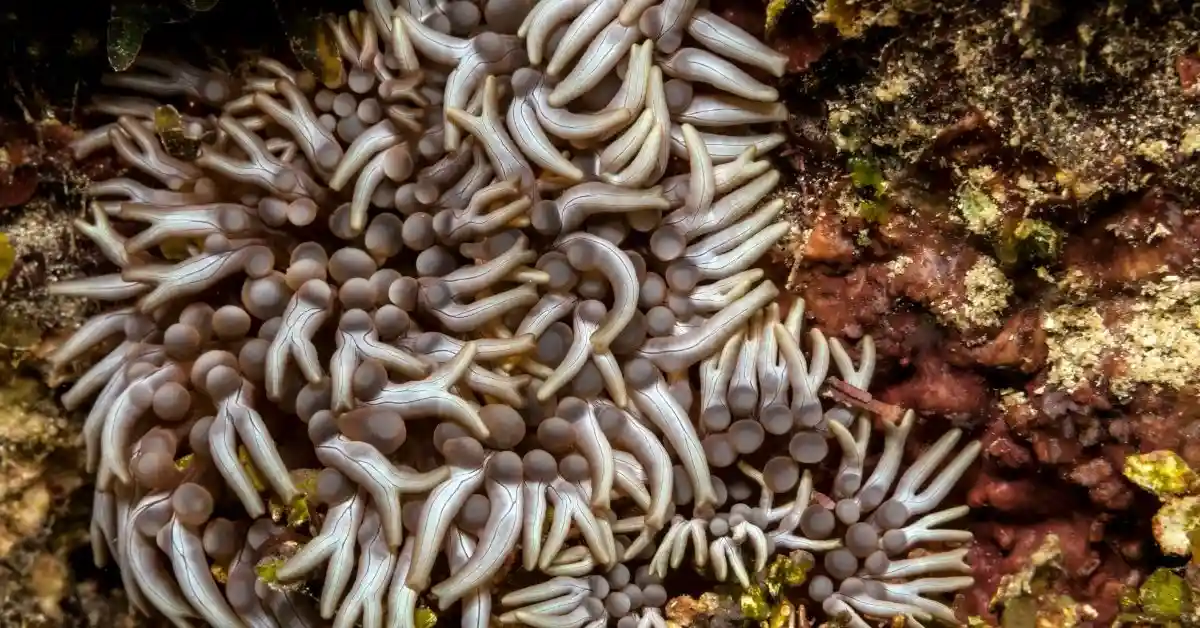Sea anemones, or just anemones, are some of the most magnificent creatures ever. But without proper care, they can die pretty easily.
That’s why every aquarist must know the dying symptoms to avoid death.
What does a dying anemone look like?
Anemone shows different symptoms when their health is endangered. Among them, the biggest sign of a dying anemone is its size.
A dying anemone can often shrink in size and become smaller. Sometimes, they can split into different pieces if they sense threats. They’ll also get detached from rocks and other corals when ill.
This is nothing but just a short answer to the entire explanation. There’s a lot to discuss and elaborate on properly. We’ve also provided multiple solutions to help you out.
Keep reading if you want to know more about sea anemones and their preservation.
3 Symptoms Of A Dying Anemone: All You Need To Know
Most aquarists start with their hobby with corals. They’re easier to keep compared to other marine creatures. One such example would be Kenya tree corals.
Even though they’re easy to keep, kenya tree corals can die easily. But anemones aren’t that easy to keep. They’re way harder to maintain.
If you’ve been an aquarist for a while, you’ve probably heard about anemones. They’re liked by many aquarists because of their beauty.
Sea anemones are a species from the phylum Cnidaria. These marine creatures are aggressive and slightly predatory. Try to imagine them as jellyfish.
Jellyfishes are way softer than corals. Anemones are super sensitive too.
That is why you need to be extra careful. Even the smallest mistake can cause them to die.
There can be many reasons behind their poor health. But knowing symptoms can easily give you a heads-up about what’s wrong.
That’s why we’ve listed some symptoms and prepared solutions for you-
Symptom 1: Anemones Have Started To Shrink In Size
This has been a super common topic for many aquarists. They often wonder whether their anemone is shrinking or not.
That’s why you’ve to check their sizes first. Normally, anemones are fluffy and stay inflated most of the time.
An ill anemone will start deflating and will get shrinked in size. Check the animals and see if they’ve shrunk or not.
If you’re not so sure, then wait a day and check again. You’ll surely notice some changes.
A deflated anemone can’t stay alive for long, 2-3 days at max. If you see a deflated one, there’s a high chance that it’s already dead.
Solution: Ensure A Proper Lighting System
Shrinked anemone can indicate poor health. Since these animals depend on light, it should be your priority.
The optimal lights for anemones are 220 – 370 PAR. Usually, good T5 bulbs or LED lights can achieve that. You can even plan on upgrading the bio cube light you have.
You can now easily choose whichever you like and get it for your anemone!
Symptom 2: Anemones Have Split Into Different Halves
Anemones splitting into multiple pieces can be another symptom. It has an in-depth reason. But mostly, they do it because of danger.
Yes, you’ve read that right. If anemones feel dangered, they decide to split themselves.
It’s a defense mechanism that they often use. It’s because two smaller anemones have a better chance of surviving rather than one.
There can be several reasons behind it. Water and food are considered the primary reasons. If there isn’t enough food or the water condition is bad, they might split.
Solution: Ensure A Moderate Water Flow
Make sure your aquarium water is always moving. It’s crucial for your anemone and other corals. Sea creatures are less likely to survive in still water.
Anemones prefer a moderate amount of water flow. Not too fast, not too slow.
Too much can make them stretch out. To ensure a moderate water flow, you’ll need a good wavemaker device.
Choose whichever you like more and get started!
Also, you’ll need some covers for them. This will prevent anemones from getting stuck.
Symptom 3: Anemones Are Getting Detached
Usually, anemones like to stay attached if they aren’t moving. It can be rocks or other corals.
They usually prey on different corals when they move around. That’s why moving your corals away is a good way to protect your corals.
Check if their feet are attached to a rock/coral or not. If they’re dying, they start to detach from surfaces. It’s a slow process, so if you notice early, you can take action.
Dying anemones get completely detached from surfaces. Some anemones can be slightly loose and stay in position even after death.
Solution: Feed Healthier Food & Bring a Variety
Food is an important factor for your anemone. Anemones should be fed at least once a week. Twice is considered optimal.
Your anemone’s size also matters when it comes to food. Smaller anemones should be fed seafood.
You can easily get them from online stores. You can also feed them small shrimps.
If your anemones are bigger, you can feed silversides or fresh shrimps. Gradually increase the quantity and monitor the health.
Other than that, sometimes alkalinity can be a factor. Like food and light, alkalinity matters, even if a little bit.
FAQs
Question: How do you save a sick anemone?
Answer: Saving a sick anemone can often prove troublesome. You will need an egg crate, a powerhead, and a small heater.
Keep the anemone on one side. After that, put the rest on the other side when doing a water change.
Question: Why is my anemone wilting?
Answer: If your anemones are wilting, it can indicate dryness. It can occur if the roots aren’t strong or developed enough. Simply put, it’s because of immaturity.
Question: Why is my anemone white?
Answer: If your anemone looks white, then it may contain algae. Algae and anemones have a synchronous relationship. If the algae get removed, they leave the anemone white.
Take Away
That was everything about what a dying anemone looks like. We hope that has shed some light on your confusion and helped you.
One last tip before we go: Make sure there aren’t any predator fish like coralfish or pufferfish. They like to prey on anemones and cause them to die.

